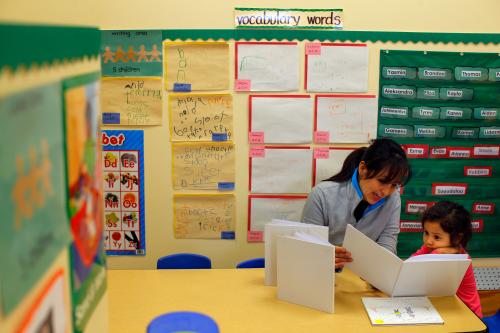Executive Summary
The standard model of the role of early experience in human development assumes that children’s environments in their first years of life are dominant influences on who they become as adults. The standard model favors interventions to improve children’s long-term outcomes that start early in life and are intensive in time and attention from nurturing adults. The benefits of such interventions, including high-quality, universal preschool programs, are assumed to accrue to children from all socio-economic strata, and to be powerful enough to substantially eliminate racial and social class differences in children’s life outcomes.
I propose a different way of thinking about the role of early experience, which I call the good-enough model. It is an evolutionary perspective that sees the human species as having evolved in circumstances that support normal development of brain and behavior in a wide range of environments, including those in which parents and communities do not invest extraordinary time and attention in the rearing of their young. It posits a floor with respect to early stimulation, the good-enough point, above which the vast majority of children will experience normal development of brain and behavior without the need for special programs or expensive enrichment experiences. A corollary is that the returns to investment in intensive early childhood programs rapidly diminish beyond the good-enough point.
The good-enough model readily incorporates research findings that are anomalies within the standard model, including seemingly high quality preschool programs that produce no long-term advantage for participants; normal later development of children reared in very impoverished early environments; weak associations between measures of cognitive abilities in toddlers and their cognitive abilities measured later in life; and genetic influences on individual differences in human cognitive and socio-emotional abilities that are orders of magnitude greater than the effects family and school environments.
The good-enough model has implications for child rearing across the range of socio-economic advantage. With respect to social programs intended to increase opportunity for children from economically disadvantaged homes, it favors investments in families and communities that open doors to children throughout their dependent years. Examples include programs that increase families’ income, stability, and employment opportunities. For advantaged families, it suggests that intensely programmed and expensive early exposure lessons and experiences intended to “grow your child’s neurons” are unlikely to be productive. For all families, it suggests how critical it is to avoid damaging experiences for young children and, by implication, the importance of attending to conditions that support the overall health of the family unit.
The standard model of early experience
Early childhood experts, advocates of investment in early learning programs, and interested members of the public generally believe that early experience is a dominant influence on the development of the cognitive and emotional characteristics of grownups. Specifically, they accept that:
- programs intended to improve the life outcomes of children should start as early in life as possible (“the evidence points to a high return to early interventions and a low return to … interventions later in the life cycle” – James Heckman);1
- more is better, i.e., every child benefits from as much intensive interaction with caring adults as possible (“children’s … cognitive, social, and emotional development is driven almost entirely by time- and attention-intensive adult nurture and care” – Katherine Stevens);2
- preschool programs can substantially reduce what would otherwise be glaring racial and social class differences in life outcomes. (“high-quality preschool is a sure path to the middle class” – Arne Duncan);3
- these things are true because of the nature of the development of the human brain.
Here’s a version of the point on brain science from a report from the U.S. Chamber of Commerce:
The infant brain has about 100 billion cells at birth—roughly the same number as an adult brain—but with many fewer connections between cells. In the first months of life, the brain’s neural network expands exponentially, from around 2,500 connections per neuron at birth to about 15,000 connections between ages 2 and 3, with rapid growth continuing into the early elementary school years …. Those connections—called synapses—“wire” the structure of a young child’s brain in response to his or her environment and cumulative experiences…. Healthy development at any stage depends on healthy development in previous stages, as more complex neural connections and skills build on earlier ones.4
Let’s call these four axioms the standard model of early human experience. They have driven two things: First is a strong and successful push to expand public early childhood programs at the state and local levels. Second is increasing investment in time and money by families on the provision of more “stimulating” environments for their young children.
Anomalies to the standard model
The standard model is more of an organizing framework than a formal, straightforwardly testable scientific theory. But to the degree that it fails to organize bodies of reliable observations to which it should be applicable, there is good reason to reconsider it.
There are a number of empirical anomalies to the standard model. I briefly review five: 1) preschool programs that do not improve and sometimes harm children’s later development; 2) normal developmental outcomes in children who have experienced very impoverished early environments; 3) weak correlations between measures of cognitive development in infants and toddlers and their later cognitive abilities; 4) disproportionately larger positive impacts of universal preschool programs on the most disadvantaged children; and 5) the strong genetic influence on many of the characteristics of children that early childhood programs are intended to influence.
Preschool programs that do not improve and sometimes harm children’s later development
The Head Start Impact Study, a randomized trial comparing four-year-olds who won vs. lost a lottery to attend oversubscribed Head Start centers across the nation, found positive effects on outcomes such as letter knowledge at the end of the Head Start year for winners of the lottery. However, there were no later differences between the treatment and control group of children as they were followed through the 3rd grade. This was true for cognitive as well socio-emotional abilities. From the final government report of the study results:
Looking across the full study period, from the beginning of Head Start through 3rd grade, the evidence is clear that access to Head Start improved children’s preschool outcomes across developmental domains, but had few impacts on children in kindergarten through 3rd grade.5
The Tennessee Voluntary Pre-K Evaluation exposes a second failed large-scale preschool intervention. It was a randomized trial comparing children who won vs. lost a lottery to attend the public pre-K program in Tennessee. As was the case in the Head Start Impact Study, there were positive impacts of the program at the end of the pre-K year. But as the children moved through elementary school, the treatment group actually did worse than the control group. From the peer-reviewed report of the study results:
Positive achievement effects at the end of pre-k reversed and began favoring the control children by 2nd and 3rd grade. [Program] participants had more disciplinary infractions and special education placements by 3rd grade than control children…. On the 3rd grade state achievement tests for the full randomized sample – pre-k participants did not perform as well as the control children. Teacher ratings of classroom behavior did not favor either group overall, though some negative treatment effects were seen in 1st and 2nd grade.6
A third example comes from evaluations of the Quebec childcare program. In 1997, the Canadian province of Quebec introduced a universal childcare program that provided heavy subsidies to childcare providers and required only a small payment by parents ($5 a day, later raised to $7). Uptake of the program was substantial, and mothers of young children entered the workforce at a substantially higher rate than was the case prior to the program’s existence. Researchers have been evaluating the impacts of the program on children ever since using quasi-experimental methods. The gist of the findings is that the program had little effect on cognitive achievement, but substantial long-term negative impacts on social adjustment. In the words of the authors of a recent evaluation of the impacts of the program on social skills:
We first confirm earlier findings showing reduced contemporaneous noncognitive development following the program introduction in Quebec, with little impact on cognitive test scores. We then show these non-cognitive deficits persisted to school ages, and also that cohorts with increased child care access subsequently had worse health, lower life satisfaction, and higher crime rates later in life.7
There are many other studies that are consistent with the findings of the three described above. For example, there is no association between differences among states in their pre-K enrollment and differences in their NAEP scores in fourth grade.8 In general, the evidence questioning the power of contemporary public preschool programs in the U.S. to meaningfully enhance later development, much less to “provide a sure path to the middle class”, is much heartier than the science supporting the standard model.
Normal developmental outcomes in children who have experienced very impoverished early environments
The empirical underpinnings of the policy prescriptions of the standard model are at their strongest in observations of long-term negative impacts of impoverished early childhoods. Classic studies involve follow-up of children adopted internationally from custodial state orphanages. Children who spend the first year or more of their life in such institutions sometimes display serious behavioral and cognitive deficits as they progress though childhood and into adulthood.
But there is a countervailing story that receives much less attention. It includes the resilience of many children who are adopted after having spent the first part of the life in a low-quality orphanage. From a recent systematic review of the literature:
While the rates of problems are higher in PI [post-institutionalized] children than in parent-reared children, most PI children fall in the normal range of adjustment; PI children often show remarkable resiliency, despite the challenges they faced early in life.9
Important here is largely forgotten research of nearly 50 years ago by Harvard developmental psychologist Jerome Kagan on the development of infants in rural Guatemalan villages.
The observed infants were permitted very little activity in the first 15 months of life, were not allowed outside their family hut, had little to play with, and were seldom played with. Compared to American infants, the Guatemalan children were extremely passive and delayed in measures of attention during infancy. However, by pre-adolescence these children had caught on and performed comparably to American middle class norms on tests of perceptual analysis, perceptual inference, recall. and recognition memory. They smiled, talked, and were intellectually competent. This, even though their environments in early childhood contained only about 20% of the interactions with adults that are typical in American families.10
That children’s later development is prototypically in the normal range despite early environments that are shockingly deficient by contemporary standards is difficult to reconcile with the tenets of the standard model.
Weak correlations between measures of cognitive development in infants and toddlers and their later cognitive abilities
One of the tenets of the standard model is that earlier intervention is better than later intervention, and that a key to understanding why is the rapid growth of neural synapsis during the first years of life. But short of substantial deprivation, it isn’t clear that cognitive growth in later childhood builds on cognitive experience in the first year or two of life.
Relevant here is that the leading test of infant cognitive development, The Bayley Scales of Infant and Toddler Development, generates scores that are only very weakly predictive of cognitive ability at later stages of development. For instance, the Bayley cognitive development scores from infants at one year of age correlate only .20 with their IQ scores at 7 years of age, i.e., they account for less than 5% of the variance in children’s 2nd grade IQ scores.11
The previously described orphanage studies are relevant as well to the disconnect between the circumstances and outcomes of development in the first two years of life versus later in the preschool period. Those studies frequently find an inflection point in later outcomes that occurs around 18 months of age at adoption. Children who are younger than 18 months when they are adopted are not likely to experience problems in later years despite the barren environmental circumstances of their first year and a half of life.12 In the standard model, healthy development as an infant or toddler should not occur in an orphanage that provides little more than nutritional support to its wards. And since healthy development in later stages depends on healthy development in earlier stages, adoption at 18 months should not erase the effects of severe deprivation of stimulation and human interaction prior in the first year or so of life.
Disproportionately larger positive impacts of universal preschool programs on the most disadvantaged children
One of the tenets of the standard model is equipotentiality (#2 in my initial list), meaning that children at any and all points of the distribution of environmental advantage can benefit from more time, intensity, and quality in their interactions with caring adults. This premise plays out in advocacy for universal vs. targeted early childhood programs. And it is the implicit foundation of the superparent phenomenon, i.e., a parent who lavishes extraordinary time and resources in providing “stimulating” activities and a “healthy” environment for her developing child, doing so in the belief that these investments will pay off in the child’s later success.
But the research is crystal clear that whether effects of preschool programs are measured contemporaneously or later in a child’s life, it is children from the most disadvantaged backgrounds that receive the most benefit. From a recent consensus statement on the subject from established scholars in the field, grounded on a systematic literature review:
Studies of different groups of preschoolers often find greater improvement in learning at the end of the pre-k year for economically disadvantaged children and dual language learners than for more advantaged and English-proficient children.13
Strong genetic influence on many of the characteristics of children that early childhood programs are intended to influence
Early model preschool programs, including Perry and Abecedarian, were intended to enhance children’s IQ and school achievement. More recently, the bearers of the standard model have shifted their emphasis to soft skills in conceptualizing and measuring the impacts of programs intended to boost the long-term outcomes of young children. The proposition is that preschool programs improve later outcomes for children by enhancing their personality traits such as agreeableness, conscientiousness, and openness to experience.14
But both cognitive abilities as measured by IQ and achievement tests and personality traits such as conscientiousness measured through surveys are heavily influenced by the DNA passed from parents to their biological children. Several independent studies converge on the estimate that a bit more than 40 percent of the variance in major personality traits is due to genes whereas only 7 percent is due to home and school. For conscientiousness, the personality trait that is most often considered a key outcome for preschool intervention, the estimate of heritability from the four most recent studies is 49 percent.15 Estimates of heritability of IQ are even higher.16
This is not to conclude that early childhood environments cannot influence personality and IQ, but it does suggest that large enduring impacts on these outcomes from a year or two in preschool are unlikely to overcome the influence of genes and family environment.
An alternative: the good-enough model of early experience
An alternative to the standard model, the good-enough model, incorporates each of the anomalies described above while leaving a significant role for public programs and parental activities intended to enhance outcomes and opportunities for children from disadvantaged families.
The root tenet of the good-enough model is that the human species has evolved in circumstances that support normal development of brain and behavior in environments that have been typically experienced by our species. These environments are not ones in which parents invest extraordinary time and attention in the rearing of their young children. Rather, these are environments in which there are diminishing returns in terms of evolutionary advantage and survival of the family unit to investments in the care and nurturing of young children. In this framework, our species evolved epigenetic mechanisms of development that require nothing more than adequate, or good-enough, levels of nutrition and critical forms of environmental interaction. These developmental mechanisms are heavily regulated genetically and well-buffered from the variations in environmental experience that are within the range typically encountered by the species.
In contrast to the standard model, the good-enough model suggests that earlier intervention is not necessarily better than later intervention; more intensive social interactions with adults are not necessarily better than less; preschool programs are unlikely to eliminate differences in outcomes and opportunity for children from different family backgrounds; and the dramatic growth in neuronal synapses during the first years of life is going to happen for all biologically normal children without heavy lifting by parents or society.
The following points provide additional background on the good-enough model.
The human species has an extended period of early development because our fully formed brains are much too large to pass through the birth canal
Humans differ from other primates in many ways, but most importantly in the size of their brains. This evolutionary path was taken by the human species because big brains were more useful than big muscles in adapting to the varied environments in which humans evolved.
The growth in skull size relative to body size that was necessary to accommodate evolution towards ever larger brains ran head on, so to speak, into the mechanical constraint of the size of the birth canal. Rather than scale-up the size of females so that they could give birth to infants with brains as fully formed as in other primates (in that case, human neonates would have weighed more than 20 lbs.), evolution took the path of delaying anatomical development of the brain into the postnatal period.
In humans the brain is 23% of its adult size at birth whereas it is 40% in chimps, and while chimps reach 70% of their final brain capacity within a year of birth, humans take three years.17 Thus the rapid brain growth that occurs in the intrauterine environment for all primates continues far longer after birth for humans. One way this has been characterized is that with respect to brain development humans are born very prematurely.18 Thus the first year or so of post-uterine life for a human baby is not primarily about soaking up experience and from that growing synapses, but about continuing the anatomical development of the brain that would occur in an intrauterine environment if only human brains were smaller.
Darwinian selection for the human species favors large allowances for differences in experience and parental investment in nurturing
As a species, humans have a low frequency of reproduction, low litter size, and offspring with an extended period of dependency. If the purpose of our large brains is to give us a reproductive advantage, one could question why evolutionary forces would condition the ultimate usefulness of that large brain on individual differences among adults in individual family units in the time and intensiveness of their interactions with their young. In that scenario, children in families in which the adults did not have the capacity to invest their time heavily in nurturing interactions with their young children would not develop normal brains. And failing in that, they and their species would be at a severe disadvantage in the competition to survive to adulthood and reproduce.
It would make more sense from an evolutionary perspective for the normal development of the human brain during the period of early childhood to be well-buffered against the variations and vicissitudes in child-rearing environments that would ordinarily be encountered across family units and circumstances of living. Were this so, it would align with the perspective that what the human brain is doing in the first couple of years of life is completing the growth that would have occurred in utero were it not for humans’ need to grow very large brains. A developmental trajectory that is protected against ordinary and expected variation in environment would be baked into the design.
We understand this for physical development, i.e., we need adequate not extraordinary levels of nutrition and experience in movement for our bodies to grow normally. But for social emotional and cognitive development the standard model requires a superparent and a high-quality preschool center and enrichment classes and an hour a night of shared picture book reading (and more) for a child to realize his or her genetic potential. Adequate environment makes much more evolutionary sense than extraordinary environment as a requirement for normal development of the human species.
The good-enough model of early environment aligns with a distinction between the average expectable environment vs. the damaging environment
Nearly 30 years ago the distinguished developmental psychologist, Sandra Scarr, summed up implications for early intervention of the findings from her prior 25 years of research on the genetics of human development. She drew a critical distinction between the average expectable environment vs. a damaging environment. The former represents the typical environment a child can expect to experience regardless of broad differences in the specifics of culture, class, and family. In contrast, a damaging environment is one that interferes with a genetically programmed developmental progression.
Thus, a biologically normal child reared with virtually no exposure to language experiences a damaging environment because the unfolding of language competences that occurs in all normal members of the human species over the first few years of life depends on some exposure to language. The average expectable environment includes such exposure but tolerates wide variability in how much such exposure occurs and in what form.
In Scarr’s treatment, interventions intended to help children experiencing damaging environments can have lasting effects, whereas changing the trajectory of the lives of children experiencing something within the range of the average expectable environment, the good-enough environment in my terms, is difficult and unlikely to be transformative. As she puts it:
It is not easy to intervene deliberately in children’s lives to change their development, unless their environments are outside of the normal species range…. Feeding a below average-intellect more and more information will not make her brilliant. Exposing a shy child to socially demanding events will not make him feel less shy. The child with below-average intelligence and the shy child may gain some specific skills and helpful knowledge of how to behave in specific situations, but their enduring intellectual and personality characteristics will not be changed.19
Summing Up
The standard model of early experience, which presently drives most policy and practice in early childhood, is imperfect, at best. It faces numerous empirical anomalies and ignores alternative ways of organizing the current body of knowledge and observations on early experience. The standard model and the alternatives, such as the good-enough model presented here, have very different implications for policy and practice.
The good-enough model places the emphasis on raising the floor for the environmental interactions of early childhood to a point where it is adequate for as many children as possible. From a reform perspective it intends to reduce as much as possible environmental circumstances that are toxic for young children. It postulates a law of rapidly diminishing returns beyond the point of adequacy for investments in preschool interventions intended to enhance children’s cognitive abilities or personality traits. It favors, instead, investments in families and communities that open doors to children throughout their dependent years. Examples include programs and investments that increase family income and stability, as well as programs that improve the rearing circumstances of abused and neglected children.
The nature of the relationships between variables of early experience and later development are an empirical matter, not something to be assumed based on either the standard model or the good-enough model. The good-enough model as described here is intended not as a replacement for the standard model as the lodestar for early childhood policy and practice. Rather it provides a different framework for thinking about early experience, and thereby highlights the many unknowns around the critical and necessary policy decisions on early childhood investments.
There is simply a lot we don’t know and much we need to learn going forward. It will, I conclude, be far more productive to approach the task of improving lives through public investment in children and families if we embrace that uncertainly and proceed in ways that can chip away at it. Dependence on conceptual frameworks that often don’t fit the plain facts in front of our noses carries serious opportunity costs.
-
Footnotes
- https://www.nber.org/papers/w9495.pdf
- https://www.uschamberfoundation.org/sites/default/files/Workforce%20of%20Today%20Workforce%20of%20Tomorrow%20Report.pdf
- https://www.washingtonpost.com/opinions/arne-duncan-high-quality-preschool-is-a-sure-path-to-the-middle-class/2013/04/18/9fa194ee-a629-11e2-a8e2-5b98cb59187f_story.html?utm_term=.74d0fde957c5
- https://www.uschamberfoundation.org/sites/default/files/Workforce%20of%20Today%20Workforce%20of%20Tomorrow%20Report.pdf
- https://www.acf.hhs.gov/sites/default/files/opre/head_start_executive_summary.pdf
- https://www.sciencedirect.com/science/article/pii/S0885200618300279
- http://faculty.arts.ubc.ca/kmilligan/research/papers/bgmr2%20v18.pdf
- https://www.brookings.edu/research/does-state-pre-k-improve-childrens-achievement/
- https://www.ncbi.nlm.nih.gov/pmc/articles/PMC3739479/
- https://files.eric.ed.gov/fulltext/ED073855.pdf
- https://scholar.harvard.edu/files/fryer/files/testing_for_racial_differences_in_the_mental_ability_of_young_children.pdf
- https://www.ncbi.nlm.nih.gov/pmc/articles/PMC3739479/
- https://www.brookings.edu/wp-content/uploads/2017/04/consensus-statement_final.pdf
- https://www.nber.org/papers/w18121.pdf
- https://www.brookings.edu/research/hard-thinking-on-soft-skills/
- http://science.sciencemag.org/content/250/4978/223
- http://www.chimpanzeebrain.org/chimpanzee-brain-facts
- http://www.leeds.ac.uk/chb/lectures/anthl_06.html
- https://www.jstor.org/stable/1130897?seq=1#page_scan_tab_contents
The Brookings Institution is committed to quality, independence, and impact.
We are supported by a diverse array of funders. In line with our values and policies, each Brookings publication represents the sole views of its author(s).







